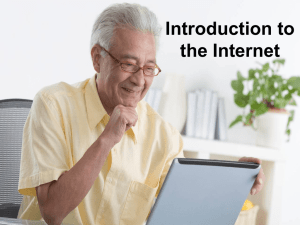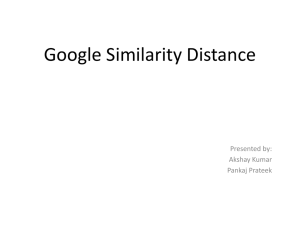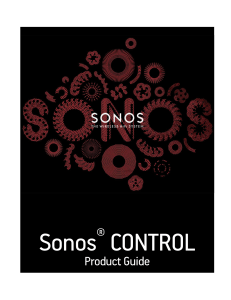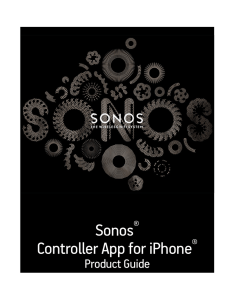PPT
advertisement
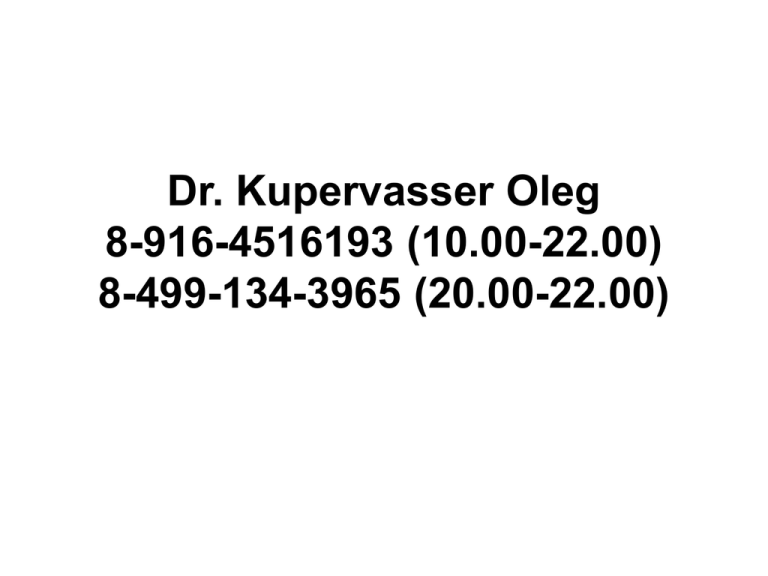
Dr. Kupervasser Oleg
8-916-4516193 (10.00-22.00)
8-499-134-3965 (20.00-22.00)
OLEG KUPERVASSER
e-mail: olegkup@yahoo.com
address: Russia, Vavilova 54-1-71 Moscow
119296
Date of birth: 01/02/1966
Citizenship: Russia, Israel
Home page:
http://leah.haifa.ac.il/~skogan/Apache/mydata1/
Oleg_home/Oleg_home.html
Education
•
•
•
•
•
2004 Haifa University: Three dimensional protein structure. Postdoctorate.
(http://leah.haifa.ac.il/~skogan/Apache/mydata1/main.html) ; Perl, DHTML,
Fortran, C++ languages
2001-2002 ATLAS college: Bioinformatics for Hi-Tech people. Final project:
Three dimensional protein structure, under supervision of Professor Edward
N. Trifonov from Weizmann Institute of Science.
Including: Basic knowledge in Biology, Bioinformatics, Programming (C++,
SQL, JAVA, DHTML, Bio-PERL, UNIX, MATLAB)
Ph.D. 1992-1999 Weizmann Institute of Science, Faculty of Physics.
Research project: Nonlinear dynamics (Analytical methods and numerical
algorithms for the solution of nonlinear physics equations). Fortran, C++
languages
1991-1992 Tel-Aviv University, Faculty of Engineering, department of
Physical Electronics, Ph.D student, Tel Aviv, Free electron laser. Fortran
languages
M.Sc. 1983-1989 Moscow Institute of Radioengineering, Electronics and
Automation. (theoretical and experimental electro-optics, laser, fiber optics
and radars) Diploma honoris causa . Fortran language.
Employment
•
2008-2010 Algorithm developer in Moscow State University, Russia, Moscow. Algorithm
developer. C++ language
Computer drug design, nano-systems computer modeling; solvent influence on molecules interaction;
took part in scientific conferences; submitted six papers and one published in high impact factor
journal
•
2009-2009 Algorithm developer in UltraSpect, Image processing in Nuclear medicine. C++
language
•
2008-2008 Algorithm developer in Vayar Vision, Israel. Images search in Internet ("Google" for
images). C++ language
This company develops a search engine for images. For some picture this search engine looks for
similar pictures in the given data basis of images. This similarity is not based on objects
recognition. The similarity is based on not semantic characters (for example, a number of the
boundaries pixels over image segments and etc.).
•
2005-2008 Rafael-Technion: Image processing, multiple view geometry of smooth bodies,
Navigation systems; took part in scientific conferences; two published papers; Matlab language
It is creation of algorithms in the field of image processing, computer vision for navigation of rockets.
For Rafael (the leading Israeli company in the field of rocket weapons) programs was developed
for navigation of rockets by means of the video images and the known terrain map. This is inverse
problem with respect to the problem solved by means of Google Earth. In Google Earth for a given
trajectory and orientation the correspondent images can be found. In the developed method a
trajectory and orientation can be found on the basis of a video. From this experience expansion of
Google Earth can be developed, allowing video-navigation for a flying plane, a rocket or a car from
a video film.
•
2003-2004 Algorithm developer in Intel , Israel. Image processing in digital TV, C++ language
•
2002-2002 Algorithm developer in UltraSpect, Israel. Image processing in Nuclear medicine, C++
languages
•
2000-2001 Algorithm developer in Orbotech LTD, Israel. Recognition of glass defects and plate
marks, Matlab, C++ languages.
•
1999-2000 Electronics engineer in Tower Semiconductor LTD, Israel. Design flash-memory, Excel
• Student physics Olympiad in Moscow (1
prize)
• Student physics Olympiad in USSA (2
prize)
• About 27 publications in physics, image
processing
Continuum solution model.
Moscow State University
Continuum solution
model.
Process of solute solvation in solvent
Three components of Gibbs
energy
• Gs =Gcav +Gnp+Gpol,
• Gcav – Hydrophobic component
•
• Gnp - Van-der-Waals component
•
• Gpol - polarization component
Methods for finding of polarization
component Gpol .
• Exact numerical methods:
– Solution of Poisson equation in 3D
– Solution of equivalent equation for charge on solvent
excluded surface (PCM)
• Simplified PCM: COSMO – water (ε=78) is changed to metal
(ε=∞).
• Exact analytical method for spherical cavity полости:
– Multipole moments method,
– Mirror charges method
• Heuristic model:
– Generalized Born,
– Surface Generalized Born.
About solute surface construction in
РСМ
Protein Loop-Lock Structure
Haifa University
We must decompose a protein on set of
closed loops. The developed Internet site
solves this task.
Protein Loop-Lock Structure
We must decompose a protein on set of
closed loops. The developed Internet site
solves this task.
Images Similarity Engine.
Vayar Vision
Similarity Engine
Similarity Engine :
Finding images similar to some given image in
some image database.
1) First step: basic features definition
2) Indexing of all images in database by help
these features
3) Indexing of some given images by help these
features
4) Finding image (or images) with maximum
feature similarity from database
large number of investigation exists in the field of
images similarity. But the current Engine:
1) Can generate almost infinity number of features
used for images similarity.
2) The system can learned from mistakes.
3) The system can be easily adaptive to some new
definition of similarity
4) The set of used feature has no semantic sense.
We don’t make recognition of objects on image
and use such no sense features as number of
pixels on object boundaries and etc.
Found similar images by help our
Engine from terragaleria site
Found similar images by help our
Engine from terragaleria site
Found similar images by help our
Engine from terragaleria site
Field of use
1) Images similarity engine in Internet (like
Google for words)
2) Finding relevant images in film for product
advertising setting
3) Finding relevant information about some
building or place from photo or film.
4) Navigation by place recognition from photo or
film (GPS equivalent) by help Google Earth
5) Find similar images for intellectual property
rights control
Vision Based Navigation from
Image Sequence and Digital
Terrain Model.
Technion
Vision Based Navigation from Image Sequence and Digital Terrain
Model.
It is creation of algorithms in the field of image processing,
computer vision for navigation of rockets. For Rafael (the
leading Israeli company in the field of rocket weapons)
programs was developed for navigation of rockets by
means of the video images and the known terrain map.
This is inverse problem with respect to the problem
solved by means of Google Earth. In Google Earth for a
given trajectory and orientation the correspondent
images can be found. In the developed method a
trajectory and orientation can be found on the basis of a
video. From this experience expansion of Google Earth
can be developed, allowing video-navigation for a flying
plane, a rocket or a car from a video film.
Vision Based Navigation from Image Sequence
and Digital Terrain Model
Two consecutive images
Compute n feature correspondences
2n constraints (u, v)
Compute pose and ego-motion that
best explain the features movement
Pose and ego-motion 12 variables
DTM
Recovering Epipolar Geometry
from Images of Smooth Surfaces
Technion
We present four methods for recovering the epipolar geometry from images of
smooth surfaces. Existing methods for recovering epipolar geometry use
corresponding feature points that cannot be found in such images. The first
method is based on finding corresponding characteristic points created by
illumination (ICPM - illumination characteristic points method). The second
method is based on correspondent tangency points created by tangents
from epipoles to outline of smooth bodies (OTPM - outline tangent points
method). These two methods are exact and give correct results for real
images, because positions of the corresponding illumination characteristic
points and corresponding outline are known with small errors. But the
second method is limited either to special type of scenes or to restricted
camera motion. We also consider two else methods, termed CCPM (curve
characteristic points method) and CTPM (curve tangent points method), for
search epipolar geometry for images of smooth bodies based on a set of
level curves with a constant illumination intensity. The CCPM method is
based on search correspondent points on isophoto curves with the help of
correlation of curvatures between these lines. The CTPM method is based
on property of the tangential to isophoto curve epipolarline to map into the
tangential to correspondent isophoto curves epipolar line. Unfortunately
these two methods give us only finite subset of solution, which usually
include "good" solution, but don't allow us to find this "good" solution among
this subset. Exception is the case of epipoles in infinity. The main reason for
such result is inexactness of constant brightness assumption for smooth
bodies. But outline and illumination characteristic points are not influenced
this inexactness. So the first pair of methods gives exact result.
Correspondent points
Epipolar geometry
Image processing in the Nuclear medicine.
UltraSpect
Diagram of parallel-hole collimator attached to a crystal of a
gamma camera. Obliquely incident gamma-rays are
absorbed by the septa.
Gamma Camera
Image Processing
Direct problem:
To get Image on gamma camera from image of
radiated particles distribution
Inverse problem:
To get image of radiated particles distribution
from Image in on gamma camera
Slice of Brain
Deinterlacing for video.
Intel
Transform of interlaced video frames to progressive video
frames.
Main problems:
Motion regions, no-smooth
boundary
Steps of Algorithm.
1) Motion detection
2) Interpolation or motion compensation
3) Detection of direction
4) Detection of angles
5) Detection of “zebra”
6) Detection of “high entropy regions”
7) taking into account history and environment
8) Fuzzy boundary between motion and no motion regions
9) Median filtering, Mean filtering over space and time.
Detection and recognition of defects on
the glass
Orbotech LTD
Types of defects: bubbles,
scratchs, dirty spots
Steps of Algorithm
1) Segmentation
2) Descriptors (features) definition
3) Finding P(Xj|Hk) , Xj-Descriptor (N), Hk - type of
defect (M)
4) Naive bayes model:
X={X1,…,XN}
P(X|Hk) =Пj P(Xj|Hk)
P (Hk|X) = P(Hk)·P(X|Hk) / P(X)
P(X)=ΣkP(Hk)· P(X|Hk)
Flash memory design
Tower Semiconductor LTD
SONOS Transistor
Flash memory design
Tower Semiconductor LTD
•
•
•
Silicon–oxide-nitride–oxide–silicon memory transistor, where information is
stored as two charges in nitride at the edges of the channel.
Silicon-Oxide-Nitride-Oxide-Silicon memmory (SONOS)
A SONOS memory cell is formed from a standard polysilicon NMOS
transistor with the addition of a small sliver of silicon nitride inserted inside
the transistor's gate oxide. The sliver of nitride is non-conductive but
contains a large number of charge trapping sites able to hold an
electrostatic charge. The nitride layer is electrically isolated from the
surrounding transistor, although charges stored on the nitride directly affect
the conductivity of the underlying transistor channel. The oxide/nitride
sandwich typically consists of a 2 nm thick oxide lower layer, a 5 nm thick
silicon nitride middle layer, and a 5—10 nm oxide upper layer.SONOS
promises lower programming voltages and higher program/erase cycle
endurance than polysilicon-based flash. SONOS distinguished from
mainstream flash by the use of silicon nitride (Si3N4) instead of polysilicon
for the charge storage material.




